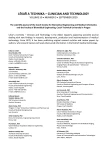OPTIMIZED CONVECTIVE VOLUME IN ONLINE HEMODIAFILTRATION
Autori:
František Lopot 1,2; Vratislav Fabián 3
Pôsobisko autorov:
Department of Medicine, General University Hospital in Prague, Prague-Strahov, Czech Republic
1; Institute of Biophysics and Medical Informatics, First Faculty of Medicine, Charles University, Prague, Czech Republic
2; Department of Physics, Faculty of Electrical Engineering, Czech Technical University in Prague, Czech Republic
3
Vyšlo v časopise:
Lékař a technika - Clinician and Technology No. 3, 2020, 50, 77-84
Kategória:
Original research
doi:
https://doi.org/10.14311/CTJ.2020.3.01
Súhrn
Hemodiafiltration (HDF) adds convective elimination of middle molecules (MM), proportional to filtered volume (Vconv) on the top of diffusion-based elimination of small molecules (SM) by conventional hemodialysis (HD). Studies, both observational and randomized controlled ones, performed so far generally indicated positive impact of higher Vconv on all-cause mortality in HDF patients, although the magnitude of Vconv at which HDF becomes apparently superior to HD differed widely among the studies. Also the issue of a suitable anthropometric parameter by which the Vconv should be normalized has not yet been solved. Data from the ESHOL study seems to indicate that patient´s body surface area (BSA) could well be used for this—mortality was decreasing with increasing Vconv/BSA with a bottom plateau starting at about 15 L/m2. We have therefore devised a formula and a graph for determination of Vconv which fulfils the requirement Vconv/BSA = 15. Assuming maximum feasible and safe filtration fraction QF/QB = 0.3, the Vconv actually defines the necessary blood flow (QB) to reach Vconv/BSA = 15 as QB = 15·BSA/(0.3·t) (t – session time). It is also possible to check what QB is needed in terms of sufficient diffusion-based transport (target Kt/V) and compare both QB values to see if adequate combined elimination of both SM and MM can be achieved at the same time and under what conditions, respectively.
Zdroje
- Gotch FA, Sargent JA. A mechanistic analysis of the National Cooperative Dialysis Study (NCDS). Kidney Int. 1985;28:526–34. DOI: 10.1038/ki.1985.160
- Eknoyan G, Beck GJ, Cheung AK, Daugirdas JT, Greene T, Kusek JW, et al. Effect of dialysis dose and membrane flux in maintenance hemodialysis. New Engl J Med. 2002;347(25): 2010–19. DOI: 10.1056/NEJMoa021583
- KDOQI Clinical practice guideline for hemodialysis adequacy: 2015 update. Am J Kidney Dis. 2015;66(5):884–930. DOI: 10.1053/j.ajkd.2015.07.015
- Eureopean Best Practice Guidelines: II.1 Haemodialysis dose quantification: small solutes. Nephrol Dial Transplantat. 2002; 17(Suppl 7):17–21.
- Maduell F, Moreso F, Pons M, Ramos R, Mora-Macià J, Carreras J, et al, ESHOL Study Group. High-efficiency postdilution online hemodiafiltration reduces all-cause mor-tality in hemodialysis patients. J Am Soc Nephrol. 2013;24(3): 487–97. DOI: 10.1681/ASN.2012080875
- Ledebo I, Blankenstijn P. Haemodiafiltration—optimal effi-ciency and safety. Nephrol Dial Transplant Plus. 2010;3(1):8–16. DOI: 10.1093/ndtplus/sfp149
- Grooteman MP, van den Dorpel MA, Bots ML, Penne EL, van der Weerd NC, Mazairac AH, et al, CONTRAST Investigators. Effect of online hemodiafiltration on all-cause mortality and cardiovascular outcomes. J Am Soc Nephrol. 2012;23:1087–96. DOI: 10.1681/ASN.2011121140
- Ok E, Asci G, Toz H, Ok ES, Kircelli F, Yilmaz M, et al. Turkish Online Haemodia-filtration Study: Mortality and car-diovascular events in online haemodiafiltration (OL-HDF) compared with highflux dialysis: results from the Turkish OLHDF Study. Nephrol Dial Transplant. 2013;28:192–202.
- White CR, Seymour RS. Allometric scaling of mammalian metabolism. J Exp Biol. 2005;208:1611–9. DOI: 10.1242/jeb.01501
- Dubois D, Dubois EF. A formula to estimate the approximate surface area if height and weight be known. Arch Intern Med. 1916;17:863–71.
- Tattersall JE, Ward RA (Eudial group). Online haemodia-filtration: definition, dose quantification and safety revisited. Nephrol Dial Transplant. 2013;28:542–50. DOI: 10.1093/ndt/gfs530
- Slavíčková E. Dialyzer fibre bundle volume measurement during dialysis, MSc dipl. thesis, Healthcare studies, 1st Faculty of Medicine, Charles University, Prague, 2006 (in Czech).
- Krivitski NM, Kislukhin VV, Snyder JW, MacGibbon DR, Kuznetsova OA, Reasons AM, Depner TA. In vivo measure-ment of hemodialyzer fiber bundle volume: Theory and vali-dation. Kidney Int. 1998;54:1751–8.
DOI: 10.1046/j.1523-1755.1998.00146.x - Kesziová A, Kinská H, Švárová B, Nejedlý B, Lopot F. Are the blood flow and cumulative blood volume suitable control and monitoring parameters of dialysis dose? EDTNA/ERCA J. 2003;29(3):118–22.
- Lopot F, Bláha J, Nejedlý B, Polakovič V. Analysis of cumula-tive blood volume-based Kt/V prescription and monitoring of its delivery. Int J Artif Organs. 2006;29(5):501 (abstract).
- Lopot F, Bláha J, Švára F, Polakovič V. A simple method for prescription and monitoring of dialysis dose Kt/V. Aktuality v nefrologii. 2007;2:57–61 (in Czech, abstract in English).
- Owen WF Jr, Chertow GM, Lazarus JM, Lowrie EG. Dose of hemodialysis and survival: differences by race and sex. J Am Med Assoc. 1998;280:1764–8. DOI: 10.1001/jama.280.20.1764
- Wolfe RA, Ashby VB, Daugirdas JT, Agodoa LY, Jones CA, Port FK. Body Size, Dose of Hemodialysis, and Mortality. Am J Kidney Dis. 2000;35(1):80–8.
DOI: 10.1016/S0272-6386(00)70305-2 - Depner T, Daugirdas J, Greene T, Allon M, Beck G, Chumlea C, et al. Dialysis dose and the effect of gender and body size on outcome in the HEMO study. Kidney Int. 2004;65(4):1386–94. DOI: 10.1111/j.1523-1755.2004.00519.x
- Greene T, Daugirdas J, Depner T, Allon M. Beck G, Chumlea C, et al. Association of achieved dialysis dose with mortality in the Hemodialysis study: An example of “dose-targeting bias”. J Am Soc Nephrol. 2005;16(11):3371–80. DOI: 10.1681/ASN.2005030321
- Daugirdas JT, et al. Kt/V rescaling to BSA - implications for different-size patients by gender. Sem Dial. 2008,21:415–21.
- Watson PE, Watson ID, Batt RD. Total body water volumes for adult males and females estimated from simple anthropo-metric measurements. Am J Clin Nutr. 1980;33(1):27–39. DOI: 10.1093/ajcn/33.1.27
Štítky
BiomedicínaČlánok vyšiel v časopise
Lékař a technika

2020 Číslo 3
Najčítanejšie v tomto čísle
- OPTIMIZED CONVECTIVE VOLUME IN ONLINE HEMODIAFILTRATION
- HEALTH FAILURE MODE AND EFFECTS ANALYSIS APPLIED TO HOME MECHANICAL VENTILATION
- PROTECTIVE ASPECTS IN CONTACTLESS INFRARED THERMOGRAPHY FEVER SCREENING
-
XANTHENE DYES-MEDIATED IN VITRO PHOTODYNAMIC
TREATMENT OF CANCER AND NON-CANCER CELL LINES
